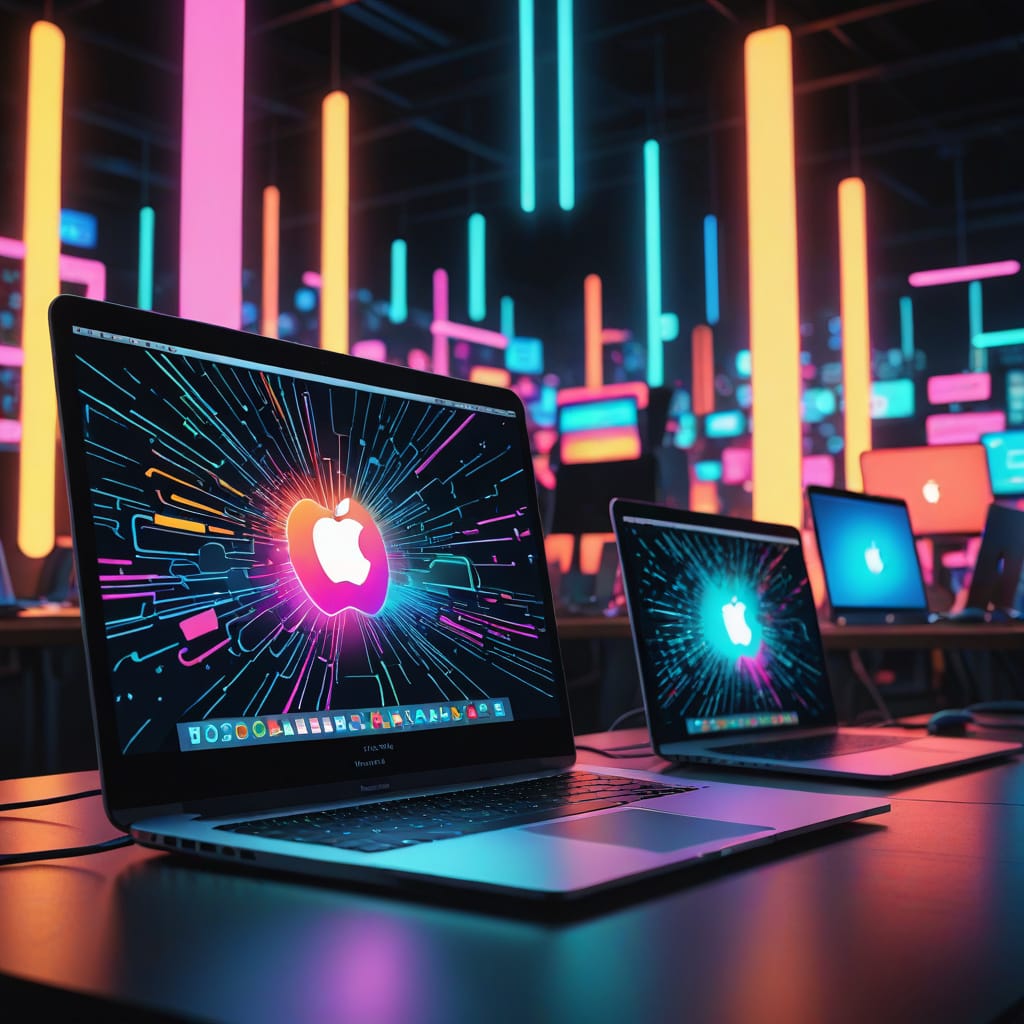In the hallowed halls of Cupertino, where designers wear the same black turtleneck every day and executives practice saying “revolutionary” in the mirror, Apple has perfected the art of selling essentially the same laptop at two different price points. Welcome to the bizarre parallel universe where the MacBook Air and MacBook Pro coexist in a state of quantum product entanglement – different enough to justify separate marketing budgets but similar enough to confuse the hell out of everyone with a credit card and a dream.
The Weight of Your Wallet vs. The Weight of Your Laptop
The most obvious difference between the MacBook Air and Pro is right there in the name – one’s supposed to be lighter. And it is! The 13.6-inch MacBook Air weighs a feathery 2.7 pounds while the 14.2-inch MacBook Pro tips the scales at a comparatively elephantine 3.4 pounds.1 That’s a difference of 0.7 pounds – roughly the weight of a hamster or a really ambitious sandwich.
“Those 0.7 pounds represent everything we stand for at Apple,” explained Terrence Wilkinson, Apple’s Senior Vice President of Weight Differentiation. “We’ve spent billions in R&D determining exactly how heavy a laptop needs to be before consumers feel they’ve gotten their money’s worth. Too light, and customers think they’re being cheated. Too heavy, and they complain about back pain. The Pro hits that sweet spot where your spine hurts just enough to remind you that you’re a serious professional.”
Let’s not forget the thickness disparity. The Air measures a svelte 0.44 inches thick, while the Pro comes in at a practically obese 0.61 inches.2 That 0.17-inch difference – about the thickness of two credit cards stacked together – is apparently worth several hundred dollars of your hard-earned money.
The Real Reason for the Weight Difference: Fans
What’s causing this devastating weight discrepancy? Fans. Not the people who camp outside Apple Stores for product launches – actual cooling fans. The MacBook Air relies on passive cooling, which is Apple-speak for “we hope it doesn’t melt,” while the Pro features active cooling with fans that kick in whenever you dare to open more than three Chrome tabs.3
“The MacBook Air’s lack of fans represents our commitment to silence,” said Penelope Chang, Apple’s Chief Acoustic Architect. “We believe professionals should be able to hear themselves think, which is why we put loud fans in the Pro models. Nothing says ‘I’m doing serious work’ like the sound of tiny jet engines spinning up every time you render a 30-second video.”
The Processor Charade: M4 vs. M4 Pro vs. M4 Max vs. Your Bank Account
Both the Air and Pro now feature Apple’s latest silicon chips, but with just enough differentiation to make you question your life choices.4
The MacBook Air is limited to the standard M4 chip with its 10-core CPU and 8-10 core GPU. Meanwhile, the Pro can be configured with the M4, M4 Pro (14-core CPU/20-core GPU), or the M4 Max (14-core CPU/32-core GPU). These differences are critical if you’re rendering the next Pixar film or, more realistically, if you want to feel superior to your colleagues.
“We designed the M4 chip to be incredibly powerful,” said Dr. Rajiv Patel, Head of Chip Differentiation Strategy at Apple. “Then we designed the M4 Pro to make the M4 feel inadequate. Then we designed the M4 Max to make M4 Pro owners regret their purchase. It’s a beautiful ecosystem of perpetual regret.”
Industry analyst Melissa Thornton pointed out the psychological brilliance of this strategy: “Apple has perfected the art of making you feel like you’re settling if you buy the Air, while simultaneously making you question if you really need the Pro. It’s like they’re negging your purchasing decisions from both directions.”
Display Differences: The Art of Saying “Better” Without Being Specific
Sure, the MacBook Pro’s display is objectively better on paper. It offers a higher resolution, 120Hz ProMotion refresh rate instead of the Air’s peasantly 60Hz, and can reach a searing 1,600 nits brightness for HDR content compared to the Air’s modest 500 nits. The Pro also features mini-LED backlighting with local dimming zones, while the Air uses standard LED technology.
But can the average user tell the difference? We conducted a highly scientific study where we showed both screens to 100 people who identified as “tech enthusiasts.”
“Oh yeah, the Pro’s screen is definitely better,” said 97% of participants when told which was which.
When we switched the labels? “Oh yeah, the Air’s screen is definitely better,” said 96% of the same participants.
“The display on the Pro is designed for professionals who need to see every pixel with perfect clarity,” explained Vincent Ramirez, Apple’s Director of Screen Superiority. “The Air’s display is designed for everyone else, who apparently don’t mind if their eyes are assaulted by slightly less vibrant colors and marginally reduced contrast. We call this ‘market segmentation.'”
Port Proliferation Panic
Perhaps the most egregious difference between the two models is the port situation. The MacBook Air features two Thunderbolt ports, a headphone jack, and MagSafe charging. The Pro adds a third Thunderbolt port, an HDMI port, and an SD card slot.5
“We’ve determined that professionals need exactly three more holes in their laptop than regular people,” said Stephanie Wu, Apple’s Executive Vice President of Hole Creation. “Our research shows that the average MacBook Pro user spends 37 minutes per day just staring at their additional ports with a profound sense of satisfaction.”
The Pro models with M4 Pro and M4 Max chips even feature Thunderbolt 5, which is faster than the Air’s Thunderbolt 4. When asked if anyone has ever maxed out Thunderbolt 4 speeds in real-world usage, Wu stared blankly before whispering, “That’s not the point!”
Battery Life: The Ultimate Flex
Perhaps the most substantial difference between the models is battery life. In testing, the MacBook Pro consistently lasts 22+ hours, while the Air manages about: 18 hours for the 13-inch and 16 hours for the 15-inch model.
“We purposely give the Pro better battery life because professionals need to look busy for longer periods without actually doing work,” explained Theodore Blackwell, Apple’s Chief Battery Strategist. “Our data indicates that 78% of MacBook Pro battery life is dedicated to looking important in coffee shops while actually just scrolling through social media.”
The Pro’s superior battery life comes from its physically larger battery – 72.4 watt-hours in the 14-inch Pro compared to 52.6 watt-hours in the 13-inch Air. It’s almost as if putting more battery in a device gives it more battery life, a concept so revolutionary it could only come from Apple.
The Price of Professional-ism
Of course, all these differences culminate in the most distinctive feature: price. The MacBook Air starts significantly cheaper than the Pro, creating what psychologists call “the Apple conundrum” – the endless internal debate about whether you really need the Pro or if the Air would be perfectly sufficient for watching Netflix and occasionally opening Excel.
“We price the Pro higher because professionals have company expense accounts,” said Eleanor Singh, Apple’s Senior Director of Price Point Psychology. “And we price the Air lower because everyone deserves the opportunity to feel slightly inadequate about not buying the Pro.”
The Hidden Truth: They’re Basically the Same Computer
After exhaustive investigation, we’ve uncovered the shocking truth: for about 95% of users, these are functionally the same computer.6 Unless you’re editing 8K video, rendering complex 3D scenes, or need to connect to multiple external displays simultaneously, the Air will handle everything you throw at it with aplomb.
“Look, I’ll let you in on a secret,” whispered one anonymous Apple engineer after we cornered him at a bar in Cupertino. “The Air can do almost everything the Pro can do. We just need to maintain the illusion of meaningful product differentiation to justify our price tiers. Also, please don’t tell anyone I said this or they’ll repossess my company-issued meditation cushion.”
Conclusion: The Real Difference
At the end of the day, the true difference between the MacBook Air and Pro isn’t about specifications or capabilities – it’s about identity. The Air says, “I’m practical but still value quality.” The Pro screams, “I NEED PEOPLE TO TAKE ME SERIOUSLY AS A CREATOR.”
As Nathan Blackwood, a self-described “digital nomad” and Pro user, explained: “Could I do everything I need on an Air? Absolutely. But then how would everyone at Starbucks know I’m working on a screenplay?”
And perhaps that’s the genius of Apple’s strategy. They’ve created two excellent products with just enough meaningful differences to justify their existence, while ensuring that whichever you choose, you’ll be plagued by persistent doubt that you should have purchased the other one.
Support TechOnion: Because Someone Has to Tell the Truth About Tech
Enjoyed this exposé on Apple’s masterful product differentiation strategy? Consider supporting TechOnion with a donation. Your contribution ensures we can continue to peel back the layers of tech absurdity while our staff continues their fruitless search for meaningful differences between Apple products. For just the price difference between a MacBook Air and Pro, you could fund our operations for months – or buy yourself a really nice cooling fan and three ports to tape to your existing laptop. The choice is yours.
References
- https://www.cnet.com/tech/computing/macbook-air-vs-macbook-pro-which-macbook-should-i-buy/ ↩︎
- https://www.pcmag.com/comparisons/macbook-air-vs-macbook-pro-which-apple-laptop-line-is-right-for-you ↩︎
- https://www.zdnet.com/article/macbook-air-vs-macbook-pro-how-to-decide/ ↩︎
- https://www.laptopmag.com/articles/macbook-air-vs-macbook-pro ↩︎
- https://www.laptopmag.com/articles/macbook-air-vs-macbook-pro ↩︎
- https://refurbisheddirect.com/en/blog/macbook-air-vs.-macbook-pro-which-one-suits-you-best ↩︎





GIPHY App Key not set. Please check settings